Table of contents
The most important question to start a presentation with
Why does having a message make or break a presentation
How to create your message
FAQ
The most important question to start a presentation with
We are here to find out why even best presenters fail 99% of the time and how to avoid this common mistake.
One of THE worst corporate experiences is to find yourself in a dull meeting labeled as a presentation (or should an author call this meeting a "death by PowerPoint"). Whether you are a listener or the presenter, that’s no fun place to be, but it still happens. And happens wa-a-ay too often.
Remember that last town hall meeting? Chances are, that most of the time you were looking at your watch, because you had more important things to do. Or maybe that one time when you’ve already read the slide, but still had to wait for another couple of minutes (it felt like days) while the presenter re-reads it before you can move on to the next one? Or maybe…alright, I’m sure you’ve got it.
The truth is, even if the presenter is energetic and you feel engaged and don’t feel an immediate urge to yawn, the presentation experience still can feel incomplete. That’s a shame because any presentation is a great opportunity to make an impact. If it is not, then it would be wise just to skip it!
If you frequently make presentations, this guide will help you avoid common pitfalls. If you are a listener, you can use one simple question to make sense of any presentation you attend. Keep it to yourself and assess silently, or ask the presenter – the choice is yours. So, what's the key to a good presentation?
Obvious, but overlooked 99% of the times
As simple as it sounds and as obvious as it might look - and way too often omitted, missed, or ignored - the single most important question to start a presentation with is, "What message do I want to deliver?"

There are various reasons why it happens, but before we dive deeper into the reasons, let me illustrate.
One of the best, if not the best, business presentations of all time took place on January 9, 2007, at the Macworld 2007 convention. Yes, the iPhone presentation.
You’ve probably come across “Make presentations like Apple” or “Apple presentation style” articles before (honestly, it is better to read this book or listen to this great podcast), quite likely sleek minimalistic slides pop up in your head when you think of Apple presentations, but the most important thing - one simple message which this presentation was built around - lives rent free deep inside your head. And that’s the superpower of great presentations.
The message was “We will change the mobile phones” (and oh, they did! Or am I convinced they did, thanks to the presentation?). Well, it was never phrased like this during the presentation, but this message was clear. Steve Jobs used the word change or changed 5 times during the first minute alone. His closing statement was:
“The iPod changed everything about music. And we are going to do it again with the iPhone in 2007”.
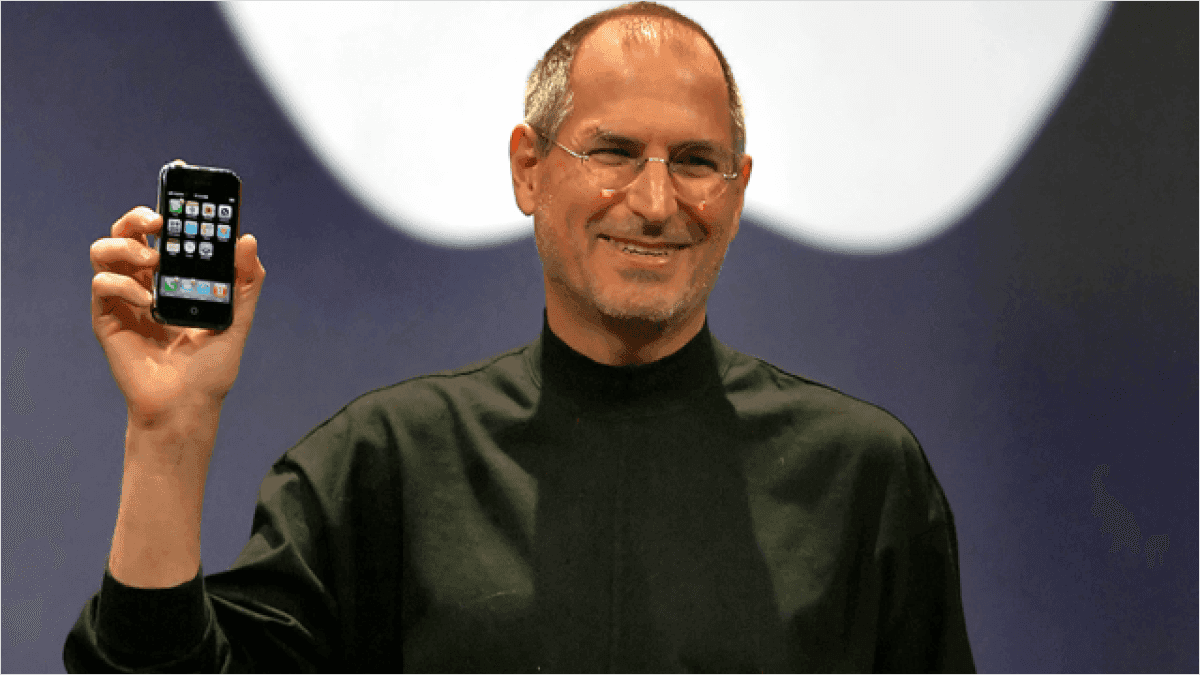
One can argue that the iPhone was so revolutionary (another word used many times during the presentation and conveying the message of change), that it sold itself and paved the way for itself. But let’s be honest, products rarely sell themselves, great presentations, in a broader sense of the word, do and do so by delivering one, precise, sticking message.
Why does having a message make or break a presentation?
Now you may wonder, if it’s so obvious, what’s the point of even talking about it? And that’s the exact reason why it is so often missed in so many presentations. Think of the last presentation you gave or listened to. Can you pinpoint and phrase this one message that was supposed to be delivered?
If the answer is no, don’t blame yourself or the presenter. The problem lies in the way our brain works, it does have a limited capacity and that is the reason why we tend to omit details that seem obvious, just to save power.
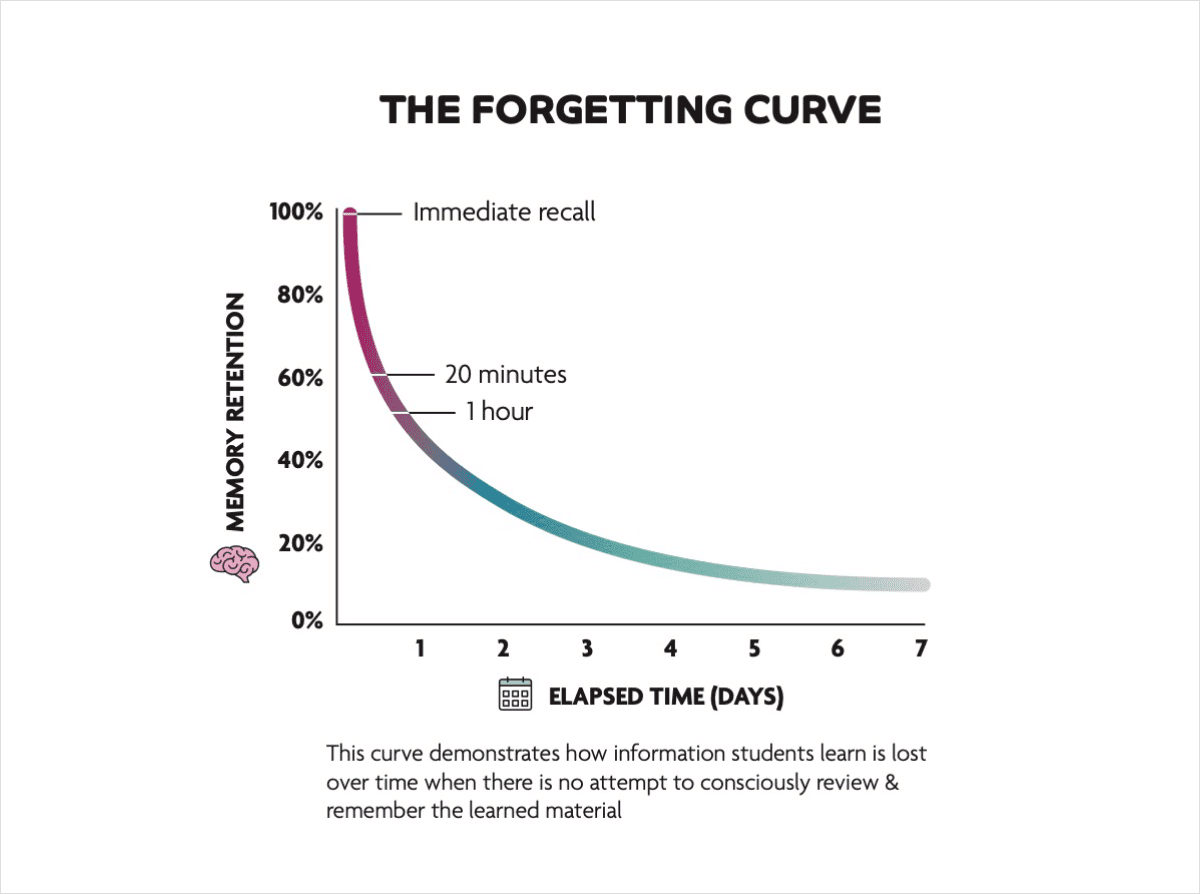
When you start preparing the presentation, the message seems clear to you, so much more effort goes into how to deliver it. And that’s the trap we all fell into. The truth is, people do not see the world the way you do, and the single most important thing when you give a presentation is to communicate your view, so it should be well refined.
“If I am to speak for ten minutes, I need a week for preparation; if fifteen minutes, three days; if half an hour, two days; if an hour, I am ready now.”
These words by President Woodrow T. Wilson are the opening lines of a book written by Nancy Duarte and highlight how difficult in fact it is to put together a simple yet powerful message.
It’s an attractive path to provide a lot of information that supports your message, putting together data and graphs might feel like time well spent, but just like a carriage turns into a pumpkin at the stroke of midnight, these efforts turn into waste if you don’t spend enough time on actually crafting the most obvious and most important part of the presentation - the message you want to deliver.
How to create your message?
To increase the chance for success of your presentation by 90% you need to put effort into 2 things:
Define how you want to change the behavior or beliefs of the people you are going to present to.
Define one key message that will nudge the audience to make the change identified in step 1.
These two things will contribute greatly to other components of a successful presentation, like supporting data, arguments visuals etc.
Start by defining current versus future state in a simple transformation matrix ↓↓↓.

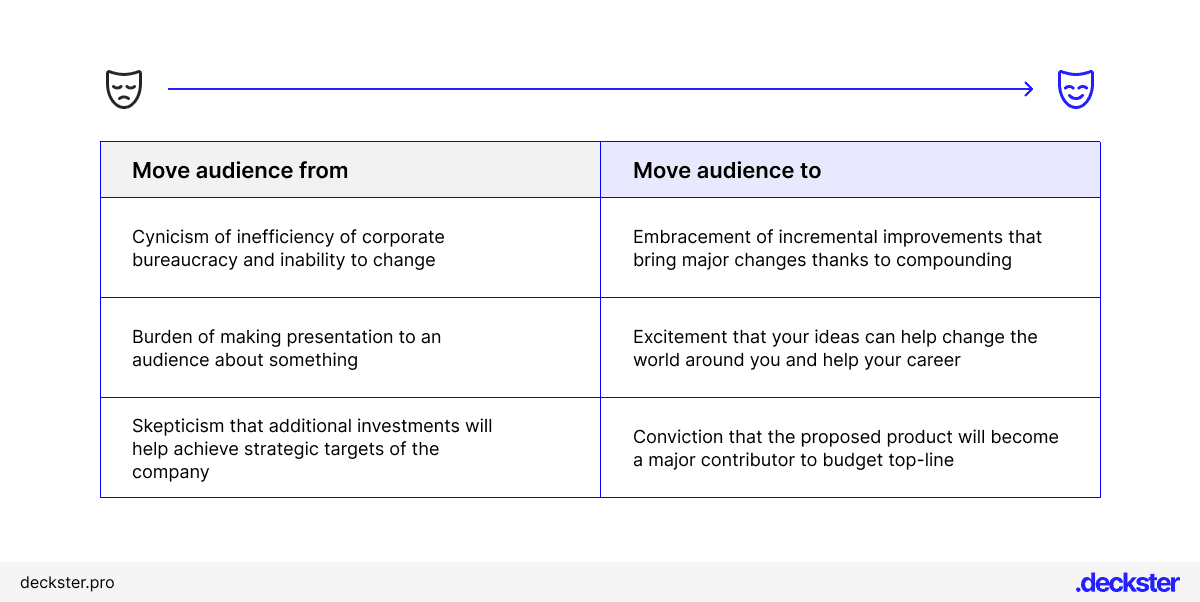
When you've defined the transformation, enhance the matrix with the main topic, your point of view and highlight what's at stake.
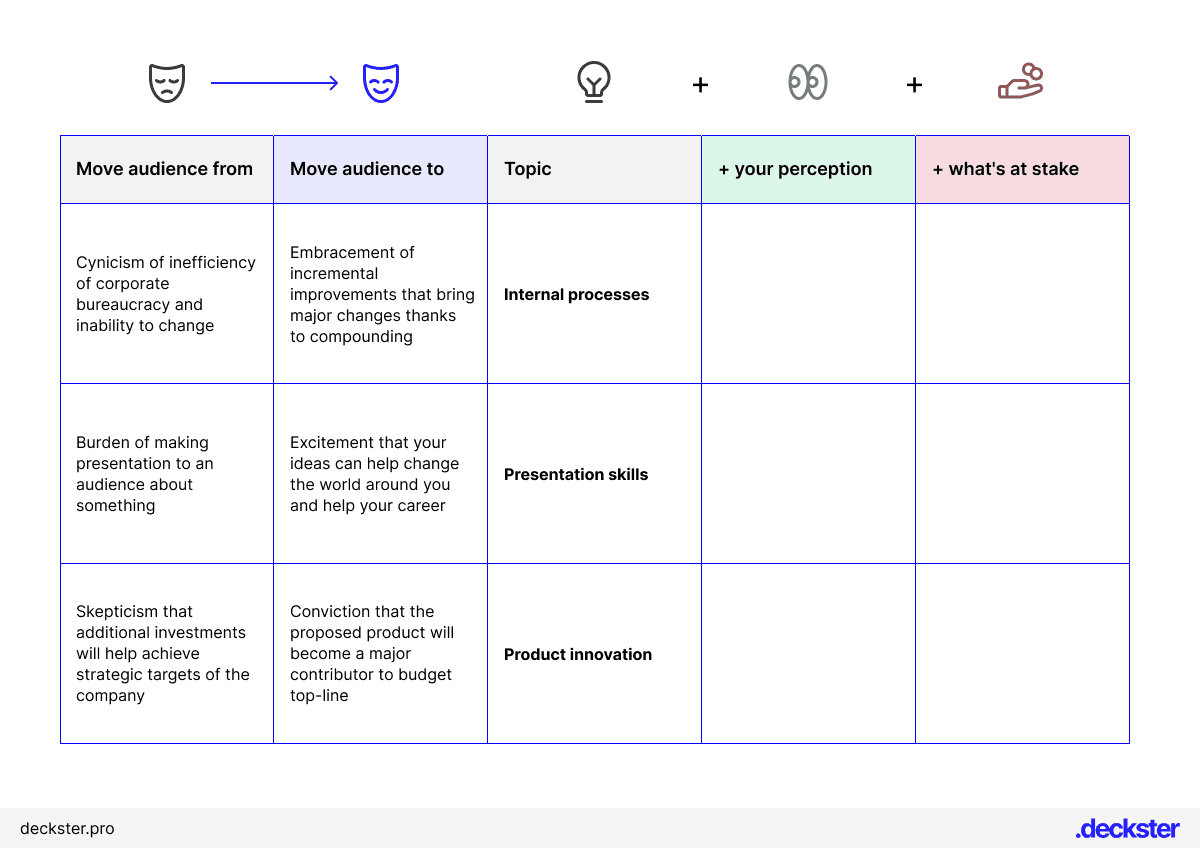
You can see that Topic alone is what is often used in presentation Titles, but it is not really conveying any message. That’s why it is important to enhance it with your point of view and impact.
Now if we enhance our matrix, the message becomes clearly better and contributes more to make the transition required.
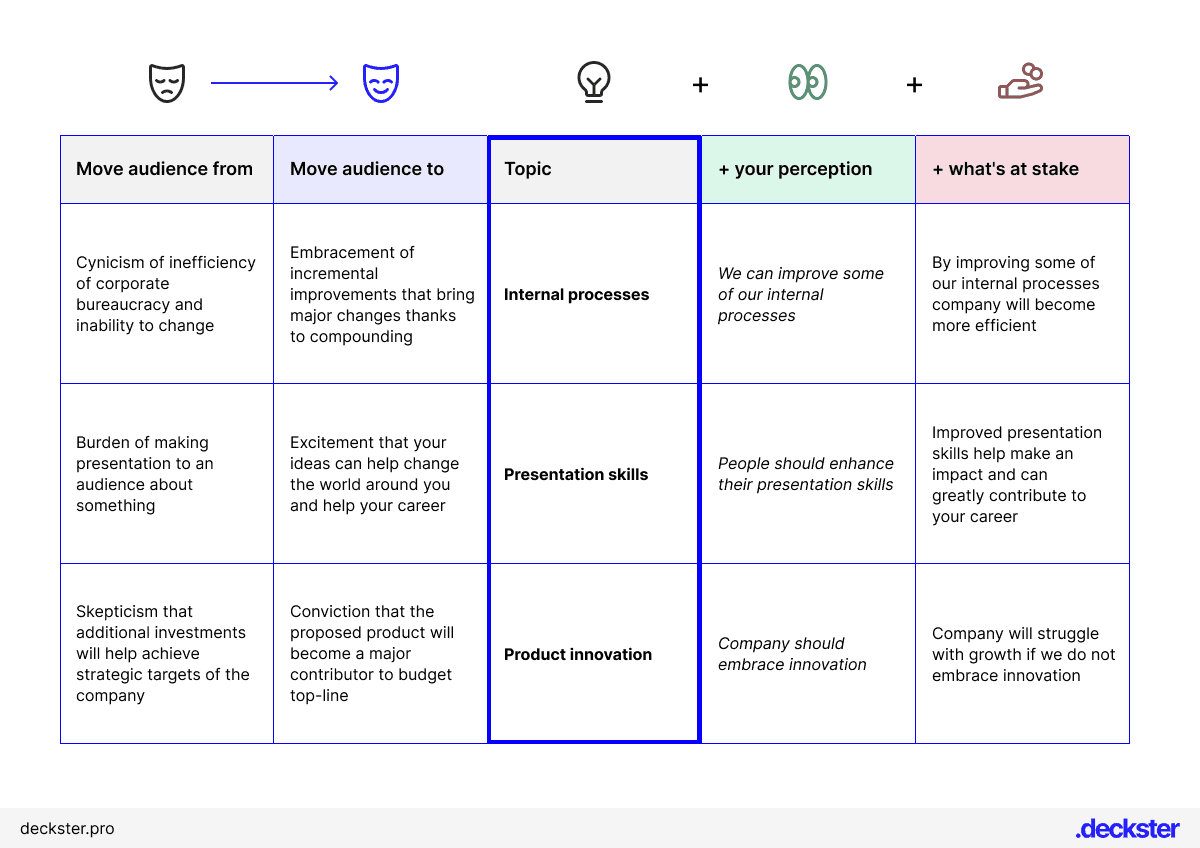
There are many persuasive techniques but A refined message is a solid foundation for the rest of your presentation. To illustrate, think of these two scenarios:
Presenter meets his department’s head and she asks:
Scenario 1
D.H: : “What’s your presentation today going to be about?”
P. : “It’s about product innovation”
Scenario 2
D.H: : “What’s your presentation today going to be about?”
P. : “It’ll be about the struggles we will face as a company, if we fail to innovate. And how we can avoid it.”
What do you think, in which case the department's head more interested in the presentation?
We at Deckster believe that there are many great ideas in the heads of bright people like you, that’s why we work hard to help you bring them to light.
Our mission is to help you deliver your message to make the world a better place, that’s why it was only the first in the series of articles. So, please, subscribe to our newsletter to stay updated and check out www.deckster.pro.
FAQ
Why do even the best presenters fail, even if they are well-prepared?
Even the best presenters can fail if they don’t focus on one clear message. If the audience doesn’t understand the main point, the presentation can feel incomplete or confusing, no matter how energetic the presenter is. The mistake often happens when the presenter focuses too much on how they deliver the presentation and not enough on making the main message clear.
How does focusing on one message make a presentation better?
When a presenter focuses on just one main message, the whole presentation becomes clearer. It helps the audience understand the key point easily. The presenter can then choose the best data and visuals to support that one idea, making the presentation stronger and easier to follow.
What is the biggest mistake people make when preparing a presentation?
The biggest mistake is adding too much extra information or data, thinking it will make the message stronger. But without a clear main message, all the extra details can confuse the audience. Instead of helping, they can make the presentation harder to understand and less effective.
